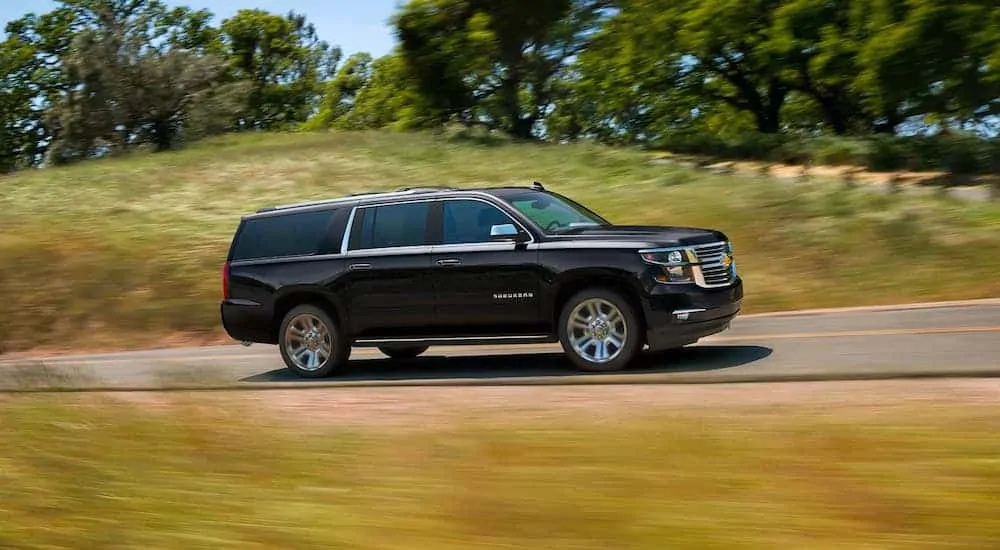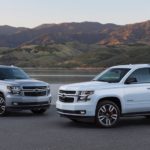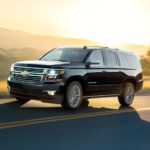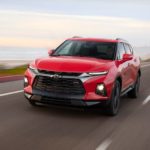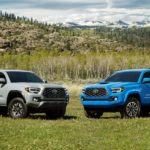Large SUVs are a special breed. These are hefty vehicles that host big engines, sprawling interiors, and when developed properly, come with so many features that it’ll make your head spin. While they often don’t exist within the luxury category, plenty can be equipped with add-ons that put them in competition with more luxurious brands. Across the landscape of 2020 SUVs, there are a handful of highlights, although two models, in particular, deserve a focus: the 2020 Chevy Suburban and the 2020 Toyota Sequoia. On the one hand, you have one of the largest Chevy SUVs in the family lineup, on the other, you have one of the most powerful models within the Toyota family. It makes sense that these two unapologetically large SUVs would rise to the forefront of buyer focus. That said, there are many potential buyers who find themselves stuck between these two models, unsure of which is the right purchase. In this article, we’ll peel back the curtain and investigate to see which of these large SUVs is the better pick.
First Impressions of the Chevy Suburban and the Toyota Sequoia
When you browse a Chevrolet or Toyota brand dealership, chances are you’ll spot both of these big SUVs amongst their collection. At first glance, though, the Toyota Sequoia may appear more appealing. Consider the price, wherein the Toyota option comes in way cheaper with an MSRP of $49,980. Comparatively, the price of the Chevy Suburban exceeds that of the competition, starting out at an MSRP of $51,700 without any additional upgrades. While the price difference can be convincing, this isn’t the only factor worth considering.
The Chevy Suburban gets a rather minimal selection of trim levels, which isn’t the worst thing in the world. Three configurations are available, the LS, LT, and Premier. While a laundry list of trims can seem appealing at first look, sometimes short and simple is effective. Alternatively, the Toyota Sequoia gets five different trim levels, which include the SR5, TRD Sport, Limited, Platinum, and TRD Pro. The Toyota Sequoia’s lineup seems to hit the sweet spot in terms of trim listings, but this really depends on what kinds of features and powertrains lie within this assortment of options.
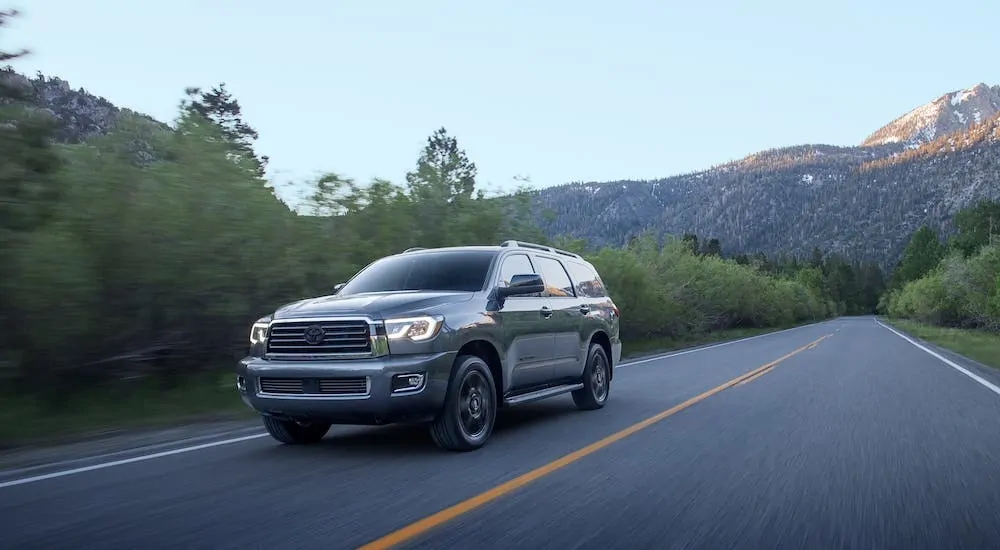
What the Performance Looks Like
Powertrains matter when shopping for a large SUV, and often times the more horsepower and torque, the better. Both the Chevy Suburban and the Toyota Sequoia start heavy when it comes to powertrain options; however, there is certainly a difference in terms of which model is the superior performer.
The Toyota Sequoia, for instance, comes as standard with a 5.7-liter V8, which is responsible for 381 horsepower and 401 lb-ft of torque. A rear-wheel drivetrain and 6-speed automatic transmission support this base engine, which manages to get the job done. However, we’d have liked to see a bigger available gearbox, as the only available 6-speed automatic is rather sluggish at times. Unfortunately, the Toyota Sequoia doesn’t offer any additional powertrain options, and while the initial entry is good, we’d have liked to at least seen a second option. That said, the Toyota Sequoia can be upgraded into a rather remarkable off-road vehicle. Towing capacity is good but limited to the 7,400-pound maximum. Step into the TRD Pro trim, and you’ll find bigger 20” wheels, an all-wheel drivetrain, and a slew of additional off-road gear.
Meanwhile, the Chevy Suburban offers up a 5.3-liter V8 as a base engine. This entry powertrain is also paired with a modest 6-speed automatic transmission and rear-wheel drivetrain that combined pumps out 355 horsepower and 383 lb-ft of torque. Although, where the Chevy Suburban manages to find an edge over the competition is in the secondary powertrain option. Step all the way up to the Platinum trim, and you’ll get a 6.2-liter V8 engine that’s paired to a 10-speed automatic transmission to make 420 horsepower and 460 lb-ft of torque. A four-wheel drivetrain is also available on all trims, drastically expanding on the vehicle’s overall versatility. That said, the Chevy Suburban will never be the ample off-road vehicle that the Toyota Sequoia can be, which can be a setback for some drivers. But, if you’re looking for superior towing, the Chevy Suburban can be tweaked to haul up to 8,300 pounds.
Sure, the Chevy Suburban may not be an off-road capable cruiser like the Toyota Sequoia, but in every other area, the Chevy Suburban outpaces the competition by a small but noticeable margin. With the performance factor out of the way, let’s take a deeper look at these two SUVs’ interiors.
A Cabin Built for Kings
When it comes to interior spacing, both of these SUVs are downright cavernous. Starting with the Toyota Sequoia, you’ll find a cargo capacity of up to 120.1 cubic feet. Rear passengers of this Toyota SUV also get 40 inches of legroom, which is bound to satisfy even the tallest passengers. Interior seating materials are on par with the competition, durable cloth in base models, with options for higher-grade materials in upgraded versions. That said, the silver plastic that graces the interior of many models of the Toyota Sequoia can feel a little antiquated.
The Chevy Suburban is just a bit bigger than the Toyota Sequoia but not by much. Offering a maximum cargo capacity of 121.7 cubic feet, and 39.7 inches of rear-seat legroom, the Chevy Suburban can feel pretty lush no matter if you’re in the front row or the third. Interior materials range from durable cloth to perforated leather. Soft-touch plastics adorn base models, however, higher-end trims add-in flashes of wood and chrome.
High-Tech Driving
Both the Chevy Suburban and the Toyota Sequoia come packed with some pretty modern technology. The Toyota Sequoia, for instance, gets a 7.0-inch infotainment touchscreen with Apple CarPlay and Android Auto, a power moon roof, and a nice set of LED headlights. Comfort amenities take a leap forward in higher trims, adding in heated seats, a Blu-ray player, speakers designed by JBL, and keyless ignition. And in typical Toyota fashion, the Toyota Sequoia comes standard with automatic emergency braking, lane-departure warnings, blind-spot monitors, and adaptive cruise control. This standard spread of active safety features is a real standout in a field of models that still require a premium cost for these add-ons.
The 2020 Chevy Suburban also offers no shortage of high-tech onboard its base models. In the LS trim, you’ll find power-adjustable front seats, an 8.0-inch infotainment touchscreen that’s built-in with Apple CarPlay and Android Auto compatible software, and a three-zone climate control system. Upgrade that standard-issue tech, and you’ll find a Bose designed audio system, keyless ignition, and heated seats. Active safety features are where the Chevy Suburban falters a bit. While the Toyota competition offers them as standard, you’ll have to pay a bit extra for these same features in the Chevy Suburban. That said, when you upgrade your model, you’ll find quite the array, including things like automatic emergency braking, a head-up display, adaptive cruise control, and so much more.
Should You Choose the Suburban or the Sequoia?
Buying a large SUV can feel like a huge investment, so it’s wise to make the right choice. While the Chevy Suburban does offer a bigger engine, a larger infotainment screen, and greater towing capacity, the Toyota Sequoia has a leg up with its off-road capability and standard safety features. Our immediate suggestion would be the Chevy SUV, but if you’re looking for an off-road friendly SUV, the Toyota Sequoia might be a good fit. Regardless of which model you go with, we highly suggest you take both for a test drive to see which might better suit your lifestyle and needs.
